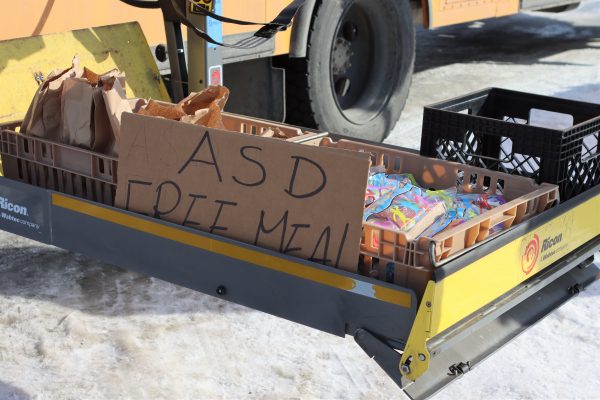
Since the COVID-19 pandemic closed down schools a year ago, one major challenge for the Anchorage School District has been feeding its more than 40,000 students.
First was the problem of getting meals to students at their homes, when in-person classes were canceled. Now, with the district increasingly bringing students back to classrooms, it’s contending with the logistical challenge of coordinating meals for kids split between their schools and their homes.
David Mayo-Kiely, who’s involved in meal service as the district’s child in transition coordinator, describes the efforts as a “moving target” — especially at times of transition, like when students are returning to in-person learning.
Those moving targets and changing plans have prompted frustration and created problems for some families looking for help, Mayo-Kiely said. With the district set to return thousands of middle and high school students to in-person learning on March 15, administrators wanted to address that frustration.
RELATED: For this Anchorage high school student, returning to the classroom can’t come soon enough
“Kids are not going to go hungry,” Superintendent Deena Bishop said at a recent school board meeting.
Mayo-Kiely said he hasn’t heard of students going hungry, but he acknowledges that can be a difficult metric to assess.
The district has assisted any family that’s asked for help by directing them to resources, Mayo-Kiely said, including partnering with organizations like United Way which received a grant to provide families with grocery store gift cards.
But with so many students relying on ASD for food, some families say that the district’s instructions for getting meal services haven’t always been clear.
At the start of the pandemic the district fed any student who showed up to designated meal sites, and hand-delivered thousands of meals along several school bus routes.
But then some distribution sites closed and picking up meals became harder for families that suddenly lived farther away from a site. Bus delivery ended, and families were asked to order meals for pick-up online. All of which created barriers to getting meals.
Stephanie Cornwell is a parent to a 5th and 8th grader in the district who sometimes uses school lunches as a meal option for her kids.
Throughout the school closure, the constantly changing logistics made it difficult to figure out where to get help, Cornwell said.
“They did it at the elementary school. And then ‘No, nevermind, we’re just going to do it at the high school,'” Cornwell said. “Just a lot of moving targets.”
Cornwell said she’s only been able to figure out where to find help through personal connections.
“If I only relied on the information from the school district, I would not be able to navigate it,” Cornwell said.
Now, as Cornwell plans to send her kids back to the classroom, she said it’s still unclear to her exactly when and how they will eat.
Secondary Director Kersten Johnson-Struempler explained how it will work at the board meeting. She said the district had to restructure breakfast and lunch periods.
“There’s some logistical issues around social distancing if we were to have a traditional lunch period, or having multiple lunches throughout the day,” Johnson-Struempler said. “Which would really drive the whole entire schedule during the day and really interrupt class times.”
For middle and high school students who don’t bring their own lunches, meals will be grab-and-go. They’ll be able to get a breakfast meal and a snack on their way in to eat during their first class of the day. And they’ll grab a lunch meal at the end of the day to eat away from the school.
Johnson-Struempler said it’s a schedule similar to what students have been doing while online learning. The goal is to prevent congregating in the cafeteria and limit passing in the hallways, she said.
It’s a new process, but she said the district has expanded meal services to more students.
“The good news is that we’re feeding more kids through our lunch program and our breakfast program than we ever have,” Johnson-Struempler said.
According to student nutrition administrators, prior to the pandemic, two of the district’s eight main high school schools were able to offer free meals to all enrolled students. Currently, all of the high schools are able to do this.
In fact, all district schools that participate in the national school lunch program will offer free meals to all students through the end of the school year, including those students who plan to continue learning online.
Families curious about where and how students can receive meals can look online at the district’s website or contact their school for specific information.




